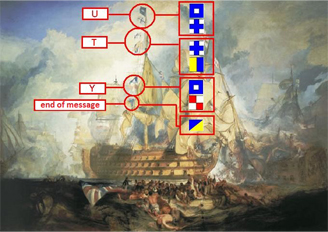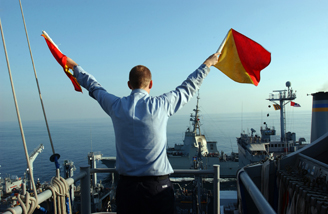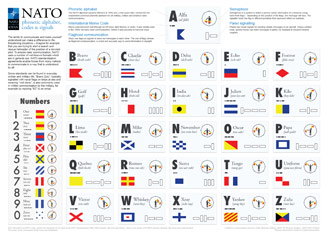NATO phonetic alphabet, codes and signals
- English
- French
The ability to communicate and make yourself understood can make a difference in life-threatening situations – imagine for example that you are trying to alert a search and rescue helicopter of the position of a downed pilot.

To ensure clear communication, NATO uses a number of well-known formats which are in general use. NATO standardization agreements enable forces from many nations to communicate in a way that is understood by all.
If you have ever said "Bravo" to mean "B" when speaking on the phone for instance, then you have used one of the most recognised standards, the NATO phonetic alphabet. However, while the phonetic alphabet is widely used and ships still use flag signals to communicate, other standards such as Morse code have become practically obsolete. Not completely though: in certain situations NATO still encodes messages via Morse using light-flashes and other visual signals because they are difficult to detect electronically.
Some standards can be found in everyday civilian and military life. "Bravo Zulu", typically signalled with naval flags on ships at sea and meaning "well done" is also commonly used in written communication by the military, for example by replying "BZ" to an email. Another standard – semaphore – inspired the peace sign. The symbol is a combination of the letters "N" and "D" (for nuclear disarmament).
Phonetic alphabet

William Turner's painting of HMS Victory at Trafalgar, with the signal flags highlighted. Source: Wikipedia
The NATO phonetic alphabet is useful to prevent spelling mistakes or miscommunication, especially when people from different countries with different accents and pronunciations work together. The NATO alphabet became effective in 1956 and, a few years later, turned into the established universal phonetic alphabet for all military, civilian and amateur radio communications. It assigns a word to each letter so that a letter's name begins with the letter itself.
International Morse Code
Morse code transmits text through on-off tones, light-flashes or clicks. It was widely used in the 1890s for early radio communication, before it was possible to transmit voice. Because Morse code has a long range, it was also used to transmit the international maritime emergency frequency (500 kHz), which was monitored by NATO ships at sea until the late 1990s. The SOS distress signal (...---...) is probably the best known message in Morse code.
Flaghoist communication
Ships use flags as signals to send out messages to each other. The use of flags, known as flaghoist communication, is a fast and accurate way to send information in daylight. Used individually or in combination, flags can form any sentence. One famous example is "England expects that every man will do his duty", a signal sent by Vice Admiral Horatio Nelson from his flagship during the Battle of Trafalgar in 1805.

A US Navy officer signals with semaphore flags during a replenishment at sea aboard a US aircraft carrier. Source: Mate Airman Javier Capella, US Navy
Semaphore
Semaphore is a system in which a person sends information at a distance using hand-held flags – depending on the position of the flags, the message will vary. The signaller holds the flag in different positions that represent letters or numbers.
Panel signalling
Panels are visual signals for sending simple messages to an aircraft. Using a limited code, ground forces can send messages to pilots, for example to request medical supplies.

